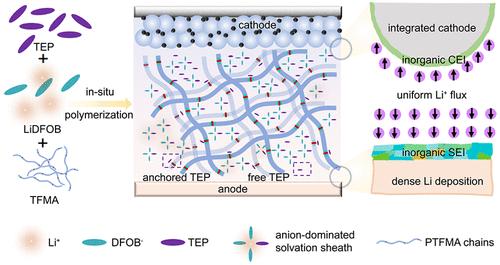Polar-Polymer-Enabled Solvent Anchoring Effect Retunes Anion-Dominated Solvation Sheath in Gel Electrolyte
IF 18.2
1区 材料科学
Q1 CHEMISTRY, PHYSICAL
引用次数: 0
Abstract
The application of nonflammable gel polymer electrolytes (GPEs) with triethyl phosphate (TEP) solvents is severely impeded by the incompatibility of free TEP molecules on electrode–electrolyte interfaces. Here, to overcome this obstacle, we synthesize an in situ designed GPE (FGPE) by incorporating fluorinated polar−polymer poly-2,2,2-trifluoroethyl methacrylate (PTFMA) into a lithium difluoro(oxalato)borate (LiDFOB)–TEP-based liquid electrolyte. An innovative TEP solvent anchoring effect via dipole–dipole intermolecular chemistry of PTFMA polymer skeleton to TEP solvents is proposed, which breaks the solvation dominance of TEP solvents and facilitates reconstruction of a DFOB–-dominated Li+ solvation sheath, thereby fostering anion-derived interfacial protective layers. Detailed interfacial resistance evolution revealed accelerated interfacial Li+ transport kinetics. Therefore, the Li|FGPE|Li cell achieves a remarkably prolonged cycle life of over 5000 h at 0.1 mA cm–2 and the Li|FGPE|LCO cell demonstrates 90.4% capacity retention after 600 cycles. This work of manipulating the solvent anchoring effect presents different insights into enhancing the interfacial compatibility of GPEs.

极性聚合物使溶剂锚定效应回归阴离子主导的凝胶电解质溶剂鞘
不可燃凝胶聚合物电解质(GPEs)与磷酸三乙酯(TEP)溶剂的应用受到游离TEP分子在电极-电解质界面上的不相容性的严重阻碍。为了克服这一障碍,我们将氟化极性聚合物聚2,2,2-三氟甲基丙烯酸乙酯(PTFMA)加入到二氟锂(草酸)硼酸锂(LiDFOB) - tep基液体电解质中,合成了原位设计的GPE (FGPE)。提出了一种新颖的通过PTFMA聚合物骨架偶极-偶极分子间化学对TEP溶剂的锚定效应,打破了TEP溶剂的溶剂化优势,促进了DFOB主导的Li+溶剂化鞘的重建,从而形成阴离子衍生的界面保护层。界面阻力的详细演化揭示了界面Li+输运动力学的加速。因此,Li|FGPE|锂电池在0.1 mA cm-2下的循环寿命显著延长,超过5000小时,Li|FGPE|LCO电池在600次循环后的容量保持率为90.4%。操纵溶剂锚定效应的工作为提高gpe的界面相容性提供了不同的见解。
本文章由计算机程序翻译,如有差异,请以英文原文为准。
求助全文
约1分钟内获得全文
求助全文
来源期刊

ACS Energy Letters
Energy-Renewable Energy, Sustainability and the Environment
CiteScore
31.20
自引率
5.00%
发文量
469
审稿时长
1 months
期刊介绍:
ACS Energy Letters is a monthly journal that publishes papers reporting new scientific advances in energy research. The journal focuses on topics that are of interest to scientists working in the fundamental and applied sciences. Rapid publication is a central criterion for acceptance, and the journal is known for its quick publication times, with an average of 4-6 weeks from submission to web publication in As Soon As Publishable format.
ACS Energy Letters is ranked as the number one journal in the Web of Science Electrochemistry category. It also ranks within the top 10 journals for Physical Chemistry, Energy & Fuels, and Nanoscience & Nanotechnology.
The journal offers several types of articles, including Letters, Energy Express, Perspectives, Reviews, Editorials, Viewpoints and Energy Focus. Additionally, authors have the option to submit videos that summarize or support the information presented in a Perspective or Review article, which can be highlighted on the journal's website. ACS Energy Letters is abstracted and indexed in Chemical Abstracts Service/SciFinder, EBSCO-summon, PubMed, Web of Science, Scopus and Portico.
 求助内容:
求助内容: 应助结果提醒方式:
应助结果提醒方式:


